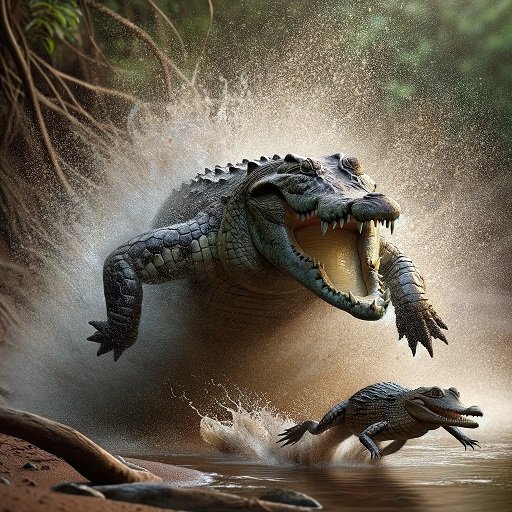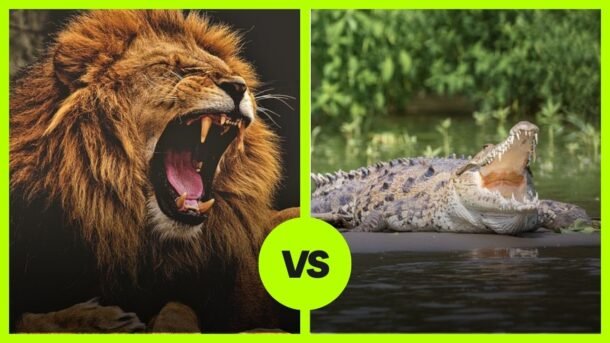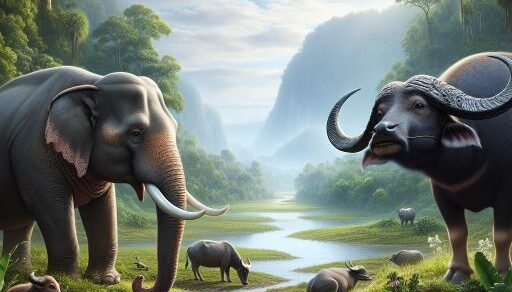In the wild, the confrontation between a crocodile and a lion is a rare spectacle, each a master of their domain. To unravel the mystery of who would emerge victorious in such a clash, we must delve deeply into their distinct hunting styles, fighting capabilities, physical attributes, and endurance.
The Crocodile: The Ambush Predator of the Waterways
Crocodiles are apex predators, ruling their aquatic territories with a blend of stealth, power, and patience. They are the epitome of ambush predators, often lying motionless for hours, partially submerged near the water’s edge. This behavior allows them to blend seamlessly with their surroundings, making them nearly invisible to unsuspecting prey.
Hunting and Killing Technique
Crocodiles have evolved to become master hunters in their aquatic environments. They rely on their exceptional ability to remain undetected until the perfect moment. When prey approaches, they explode out of their camouflaged position with surprising speed.

Their primary weapon is their jaw, equipped with powerful muscles capable of exerting tremendous force. This bite is not just about clamping down; it’s about holding and ensuring that the prey cannot escape. Once they have their jaws on their target, crocodiles often perform a death roll – a powerful and disorienting spinning maneuver designed to subdue and dismember prey.
Largest Prey and Endurance
Crocodiles are capable of taking down large and formidable animals. They have been known to hunt creatures as massive as buffaloes and even occasionally young hippos. These feats are remarkable, considering these prey are among the most robust and dangerous in the animal kingdom. However, crocodiles are not endurance hunters. They excel in short, explosive actions and do not engage in long pursuits, especially on land, where their mobility is significantly reduced.
Size and Strength
In terms of size, adult male crocodiles are daunting creatures. Some species, like the Saltwater and Nile crocodiles, can grow to lengths exceeding 20 feet and weigh over a ton. Their bodies are powerhouses, optimized for sudden bursts of speed in water. Their tails, muscular and whip-like, are not only essential for swimming but can also be used as formidable weapons in both defense and attack.
The Lion: The Quintessential Big Cat Predator
Lions, often symbolized as the ultimate big cat, are synonymous with power and majesty in the terrestrial animal kingdom. They are social creatures, living and hunting in groups known as prides, which gives them a unique advantage in the wild.
Hunting and Killing Technique
Lions have a coordinated approach to hunting, often involving complex strategies that capitalize on their numbers and individual strengths. They are ambush predators on land, using the element of surprise to their advantage. A typical lion hunt involves stealthily approaching prey, followed by a short, intense chase. Once close enough, a lion uses its powerful forelimbs to knock down the prey, delivering a fatal bite to the neck or throat. This method is designed to suffocate the prey or sever the spinal cord, ensuring a swift kill.
Largest Prey and Endurance
Lions are known to hunt large animals, including zebras, buffaloes, and occasionally young elephants. These hunts demonstrate not only their strength but also their strategic thinking and teamwork. While lions possess good endurance, they are best known for their explosive power and strength, which are crucial in taking down large prey.
Size and Strength
An adult male lion is a sight to behold. They can measure up to 10 feet in length, including their tail, and weigh between 330 to 550 pounds. Their bodies are a testament to their predatory lifestyle, with well-developed muscles, particularly in the forelimbs and shoulders, powerful jaws, and sharp claws. These physical attributes make them formidable hunters and fighters.
The Theoretical Showdown: Crocodile vs. Lion
In a hypothetical battle between these two predators, the terrain would be a crucial factor. In a water-based encounter, the crocodile’s aquatic prowess and lethal bite give it a significant advantage. The crocodile’s ability to launch a surprise attack from underwater could prove fatal for the lion.

Conversely, on land, the lion’s agility, speed, and tactical approach, especially if hunting in a pride, would likely dominate. The lion’s strategy would involve avoiding the crocodile’s powerful jaws and attacking from the sides or behind, using its agility and strength to deliver a killing blow.
Who Would Win
When evaluating the chances of victory in a hypothetical battle between a crocodile and a lion, we must consider the factors of environment, physical strength, and fighting techniques.
- In Water: In an aquatic environment, the crocodile holds a distinct advantage. Given its natural habitat and hunting adaptations, the crocodile would likely have around a 70-80% chance of winning. Its ability to maneuver in water, combined with its powerful jaws and ambush tactics, would significantly diminish the lion’s chances.
- On Land: On land, the scenario shifts dramatically in favor of the lion. With its agility, speed, and powerful hunting techniques, the lion would have approximately a 75-85% chance of winning. The lion’s ability to move quickly and strike strategically would counteract the crocodile’s strength and jaw power, which are less effective outside of water.




